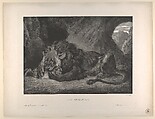Lion of the Atlas Mountains
Eugène Delacroix French
Printer Henri Gaugain French
In 1829, Delacroix and his friend the sculptor Antoine-Louis Barye had the opportunity to closely observe the dissection of a lion in Frédéric Cuvier’s laboratory at the Jardin des Plantes. According to the critic Hippolyte Taine, Delacroix later recollected his observation that the "lion’s front leg was the huge arm of a man, but twisted and turned backward." Significantly, Delacroix noted the lion’s place of origin, the Atlas Mountains of North Africa, when he titled this ambitious lithograph, published in 1830. That same year, fourteen lions arrived in the capital following France’s colonial invasion of Algeria. Big-game hunting rendered the species extinct by the early twentieth century.
Due to rights restrictions, this image cannot be enlarged, viewed at full screen, or downloaded.


